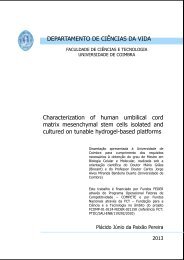role of th1 and th17 cd4+ t cell subsets in the pathogenesis of ...
role of th1 and th17 cd4+ t cell subsets in the pathogenesis of ...
role of th1 and th17 cd4+ t cell subsets in the pathogenesis of ...
Create successful ePaper yourself
Turn your PDF publications into a flip-book with our unique Google optimized e-Paper software.
<strong>the</strong> recruitment <strong>of</strong> <strong>the</strong> endogenous B <strong>cell</strong> repertoire that cooperates with <strong>the</strong> auto‐<br />
reactive T <strong>cell</strong> population to promote EAE <strong>pathogenesis</strong> (Poll<strong>in</strong>ger et al., 2009).<br />
24<br />
1.3 ‐ THE IMMUNE PLAYERS IN MS AND EAE<br />
Early studies <strong>in</strong> MS identified <strong>the</strong> immune component <strong>of</strong> this disease correlat<strong>in</strong>g <strong>the</strong><br />
<strong>cell</strong>ular composition <strong>of</strong> bra<strong>in</strong> lesions <strong>and</strong> CSF <strong>in</strong>filtrat<strong>in</strong>g <strong>cell</strong>s with data from EAE<br />
models. These studies have substantiated <strong>the</strong> contribution <strong>of</strong> <strong>the</strong> CD4 + T <strong>cell</strong>s<br />
(McFarl<strong>and</strong> <strong>and</strong> Mart<strong>in</strong>, 2007;Compston <strong>and</strong> Coles, 2002). For a long time, MS was<br />
considered a CD4 + T helper type 1 (Th1) <strong>cell</strong>s‐mediated disease <strong>and</strong> <strong>the</strong> <strong>in</strong>volvement <strong>of</strong><br />
<strong>the</strong>se <strong>cell</strong>s is consistent with <strong>the</strong> HLA association to genetic susceptibility. But today we<br />
know that <strong>the</strong> pathogenic mechanisms are by far more complex <strong>and</strong> almost all immune<br />
<strong>cell</strong> types have at least some contribution, both from <strong>the</strong> acquired <strong>and</strong> <strong>in</strong>nate immune<br />
system.<br />
Figure 1.1 – Myel<strong>in</strong>‐specific CD4 + T <strong>cell</strong>s activation <strong>in</strong> <strong>the</strong> periphery <strong>and</strong> CNS [adapted from<br />
(Goverman, 2009)].

















